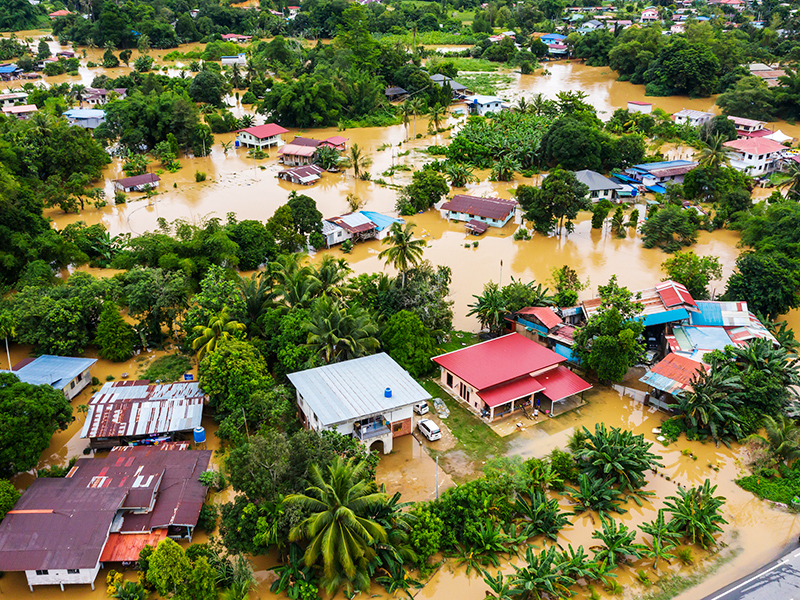
Authors
-
Samantha Harris
Former Associate Director, BSR
-
Katie Abbott
Former Manager, Inclusive Economy, BSR
For the past three years, the World Economic Forum’s annual Global Risk Report has ranked climate risks high priority in terms of likelihood and impact. For business, this includes both supply chain risks, like water scarcity, and general physical and operational risks that will require resilience and adaptation solutions.
In addition to the economic impacts on physical assets and infrastructure, climate change will have a profound effect on people in supply chains and the communities in which they operate. This human dimension is often overlooked but extremely important in addressing climate risk and ensuring business continuity.
Climate risk, climate resilience, and women
Mary Robinson, former President of Ireland and former UN Commissioner for Human Rights, said, “Climate change is the greatest threat to human rights in the 21st century,” and, “People who are marginalized or poor, women, and indigenous communities are being disproportionately affected by climate impacts.”
This is especially true for women. Women already face various underlying economic, social, cultural, and political barriers that limit their choices: barriers related to their access to income, education, and technology, as well as obstacles to exercising their public voice and decision-making. Climate change is only predicted to exacerbate these barriers.
For sectors that heavily depend on a female workforce, this presents a high material risk. Take, for example, the agriculture sector. Estimates show that in some developing countries, women make up over half of the agricultural workforce. Systemic barriers for women therefore prevent agricultural supply chains from reaching their full productive potential. These barriers can also limit the ability of a business to react, respond, and adapt to the unpredictable realities of a changing climate.
The business case for intervention—to challenge risk as well as create opportunity—is clear. A truly climate-resilient agricultural supply chain should be able to anticipate and respond to climate risks and vulnerabilities across commodities, geographies, and communities.
The good thing is that increasingly, businesses understand the importance of climate resilience strategies. Furthermore, doing so in gender-friendly ways will be a critical element of this work, although to date it has been less commonly understood and thus overlooked.
Effectively tackling climate risk will be impossible without involving women. Although they are disproportionately affected by its impacts, women bring unique skills and perspective toward climate-resilience efforts.
Applying a gender lens to resilience activities can help companies develop new solutions for anticipating, absorbing, accommodating, and rapidly recovering from climate events. Involving women in climate resilience planning and implementation fosters innovation. For example, women’s local knowledge of the land and of traditional and sustainable agricultural methods make them experts in natural resource management. And when women have information and access to tools and technology, they are more likely to adopt sustainable practices, which may include water management, terracing, composting, incorporating high-yield and stress-tolerant varieties of crops, and pasture management.
There are also many co-benefits that arise from empowering women across agricultural supply chains. Increasing women’s agency, enhancing the resilience of communities and livelihoods, and making progress toward closing the global gender gap are among them. Increasing agricultural productivity and stability of supply enables people, the economy, and natural systems to rebound quickly in the face of adversity.
Women spend 90 percent of their incomes on their families; therefore, when women make more money, more money is invested in school, health, and housing improvements. Efforts to empower women and close the gender gap in labor markets could add US$28 trillion to global, annual GDP within the next decade. It’s a clear win-win for companies to empower women through climate resilience activities.
What can companies do?
There are many actions companies can take, both within their own operations and supply chains as well as to enable and influence others, including:
- Ensuring internal policies and plans on climate change are gender-sensitive;
- Providing women with access to relevant and gender-sensitive trainings, inputs, financing, and technologies to strengthen stability in agricultural production and improve economic opportunities;
- Enabling women to effectively respond to climate-related events by linking them with local networks; and
- Advocating against underlying inequalities and removing systemic barriers that hinder the lives and livelihoods of women, such as the lack of decision-making power or land (and land inheritance rights), which exacerbate the disproportionately negative climate impacts for women.
To help business address this challenge, BSR’s Business Action for Women, “Empowering Women to Lead through Climate Resilience” cluster builds collaboration among companies with agricultural supply chains and leading women’s empowerment stakeholders. In the coming years, we will work to equip the private sector with a greater understanding of gender-sensitive climate resilience strategies and actionable methods to empower women through climate-resilient supply chains.
Companies can also engage on climate resilience and other nexus issues, including supply chains, women’s empowerment, and inclusive economy, at the Global Climate Action Summit from September 12-14 in San Francisco. Companies and other stakeholders will discuss the myriad ways to accelerate climate collaboration and action. To learn more about the Summit and how you can get involved, register for our webinar on May 16.
BSR’s latest sustainability insights and events straight to your inbox.
Topics
Let’s talk about how BSR can help you to transform your business and achieve your sustainability goals.







